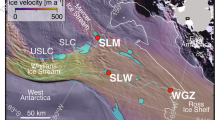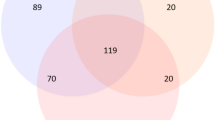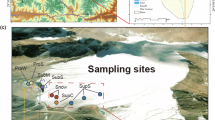Abstract
Subglacial lakes beneath the Vatnajökull ice cap in Iceland host endemic communities of microorganisms adapted to cold, dark and nutrient-poor waters, but the mechanisms by which these microbes disseminate under the ice and colonize these lakes are unknown. We present new data on this subglacial microbiome generated from samples of two subglacial lakes, a subglacial flood and a lake that was formerly subglacial but now partly exposed to the atmosphere. These data include parallel 16S rRNA gene amplicon libraries constructed using novel primers that span the v3–v5 and v4–v6 hypervariable regions. Archaea were not detected in either subglacial lake, and the communities are dominated by only five bacterial taxa. Our paired libraries are highly concordant for the most abundant taxa, but estimates of diversity (abundance-based coverage estimator) in the v4–v6 libraries are 3–8 times higher than in corresponding v3–v5 libraries. The dominant taxa are closely related to cultivated anaerobes and microaerobes, and may occupy unique metabolic niches in a chemoautolithotrophic ecosystem. The populations of the major taxa in the subglacial lakes are indistinguishable (>99% sequence identity), despite separation by 6 km and an ice divide; one taxon is ubiquitous in our Vatnajökull samples. We propose that the glacial bed is connected through an aquifer in the underlying permeable basalt, and these subglacial lakes are colonized from a deeper, subterranean microbiome.
Similar content being viewed by others
Log in or create a free account to read this content
Gain free access to this article, as well as selected content from this journal and more on nature.com
or
Accession codes
References
Abicht HK, Mancini S, Karnachuk OV, Solioz M . (2011). Genome sequence of Desulfosporosinus sp. OT, an acidophilic sulfate-reducing bacterium from copper mining waste in Norilsk, northern Siberia. J Bacteriol 193: 6104–6105.
Ágústsdóttir AM, Brantley SL . (1994). Volatile fluxes integrated over four decades at Grímsvötn volcano, Iceland. J Geophys Res 99: 9505–9522.
Alazard D, Joseph M, Battaglia-Brunet F, Cayol J-L, Ollivier B . (2010). Desulfosporosinus acidiphilus; sp. nov.: a moderately acidophilic sulfate-reducing bacterium isolated from acid mining drainage sediments. Extremophiles 14: 305–312.
APHA (2005) Standard Methods for the Examination of Water and Wastewater, 21st edn. Washington: DC, USA.
Arnórsson S, Gunnlaugsson E, Svavarsson H . (1983). The chemistry of geothermal waters in Iceland. 2. Mineral equilibria and indepdent variables controlling water composition. Geochim Cosmochim Acta 47: 547–566.
Balch WE, Fox GE, Magrum LJ, Woese CR, Wolfe RS . (1979). Methanogens: re-evaluation of a unique biological group. Microbiol Rev 43: 260–296.
Björnsson H . (1988) Hydrology of Ice Caps in Volcanic Regions. Societas Scientarium Islandica: Reykjavik, Iceland.
Björnsson H . (2002). Subglacial lakes and jökulhlaups in Iceland. Global Planet Change 35: 255–271.
Boyd ES, Skidmore M, Mitchell AC, Bakermans C, Peters JW . (2010). Methanogenesis in subglacial sediments. Environ Microbiol Rep 2: 685–692.
Bray JR, Curtis JT . (1957). An ordination of the upland forest communities of southern Wisconsin. Ecol Monogr 27: 325–349.
Cavicchioli R . (2006). Cold-adapted archaea. Nat Rev Microbiol 4: 331–343.
Chapelle FH, O’Neil K, Bradley PM, Methé BA, Ciufo SA, Knobel LL et al (2002). A hydrogen-based subsurface microbial community dominated by methanogens. Nature 415: 312–314.
Christner BC, Mosely-Thompson E, Thompson LG, Zagorodnov VS, Sandman K, Reeve JN . (2000). Recovery and identification of viable bacteria immured in glacial ice. Icarus 144: 479–485.
Cuffey KM, Paterson WSB . (2010) The Physics of Glaciers 4th edn. Elsevier: Amsterdam.
Czekanowski J . (1909). Zur Differentialdiagnose dr Neandertalgruppe. Korrespbl dt Ges Antrop, 44–47.
Davidson MM, Silver BJ, Onstott TC, Moser DP, Gihring TM, Pratt LM et al (2011). Capture of planktonic microbial diversity in fractures by long-term monitoring of flowing boreholes, Evander Basin, South Africa. Geomicrobiol J 28: 275–300.
Degryse E, Glansdorff N, Pierard A . (1978). A comparative analysis of extreme thermophilic bacteria belonging to the genus Thermus. Arch Microbiol 117: 189–196.
DeSantis TZ, Hugenholtz P, Larsen N, Rojas M, Brodie EL, Keller K et al (2006). Greengenes: a chimera-checked 16S rRNA gene database and workbench compatible with ARB. Appl Environ Microbiol 72: 5069–5072.
Drake HL, Küsel K, Matthies C . (2002). Ecological consequences of the phylogenetic and physiological diversities of acetogens. Antonie Van Leeuwenhoek 81: 203–213.
Edgar RC, Haas BJ, Clemente JC, Quince C, Knight R . (2011). UCHIME improves sensitivity and speed of chimera detection. Bioinformatics 27: 2194–2200.
Entry JA, Farmer N . (2001). Movement of coliform bacteria and nutrients in ground waters flowing through basalt and sand aquifers. J Environ Qual 30: 1533–1539.
Felsenstein J . (1989). PHYLIP—phylogeny inference package (version 3.2). Cladistics 5: 164–166.
Finster K, Liesack W, Tindall BJ . (1997). Sulfurospirillum arcachonense sp. nov., a new microaerophilic sulfur-reducing bacterium. Int J Syst Bacteriol 47: 1212–1217.
Flowers GE, Björnsson H, Pálsson F . (2003). New insights into the subglacial and periglacial hydrology of Vatnajökull, Iceland, from a distributed physical model. J Glaciol 49: 257–270.
Gaidos E, Lanoil B, Thorsteinsson T, Graham A, Skidmore M, Han S-k et al (2004). A viable microbial community in a subglacial volcanic crater lake, Iceland. Astrobiology 4: 327–344.
Gaidos E, Marteinsson V, Thorsteinsson T, Jóhannesson H, Rafnsson AR, Stefansson A et al (2009). An oligarchic microbial assemblage in the anoxic bottom waters of a volcanic subglacial lake. ISME J 3: 486–497.
Gaidos EJ, Nealson KH, Kirschvink JL . (1999). Life in ice-covered oceans. Science 284: 1631–1633.
Giggenbach WF . (1980). Geothermal gas equilibria. Geochim Cosmochim Acta 44: 2012–2032.
Gilles A, Meglecz E, Pech N, Ferreira S, Malausa T, Martin J-F . (2011). Accuracy and quality assessment of 454 GS-FLX Titanium pyrosequencing. BMC Genom 12: 245.
Haas BJ, Gevers D, Earl AM, Feldgarden M, Ward DV, Giannoukos G et al (2011). Chimeric 16S rRNA sequence formation and detection in Sanger and 454-pyrosequenced PCR amplicons. Genome Res 21: 494–504.
Hoehler TM . (2004). Biological energy requirements as quantitative boundary conditions for life in the subsurface. Geobiology 2: 205–215.
Horn H . (1966). Measurement of overlap in comparative ecological studies. Am Nat 100: 419–424.
Huse SM, Dethlefsen L, Huber JA, Mark Welch D, Relman DA, Sogin ML . (2008). Exploring microbial diversity and taxonomy using SSU rRNA hypervariable tag sequencing. PLoS Genet 4: e1000255.
Huse SM, Welch DM, Morrison HG, Sogin ML . (2010). Ironing out the wrinkles in the rare biosphere through improved OTU clustering. Environ Microbiol 12: 1889–1898.
Jensen A, Finster K . (2005). Isolation and characterization of Sulfurospirillum carboxydovorans sp. nov., a new microaerophilic carbon monoxide oxidizing epsilon Proteobacterium. Antonie Van Leeuwenhoek 87: 339–353.
Jóhannesson T, Thorsteinsson T, Stefánsson A, Gaidos E, Einarsson B . (2007). Circulation and thermodynamics in a subglacial geothermal lake under the Western Skaftá cauldron of the Vatnajökull ice cap, Iceland. Geophys Res Lett 34: L19502.
Kaasalainen H, Stefánsson A . (2011). Sulfur speciation in natural hydrothermal water, Iceland. Geochim Cosmochim Acta 75: 2777–2791.
Kemp PF, Aller JY . (2004). Estimating prokaryotic diversity: when are 16S rDNA libraries large enough? Limnol Oceanogr Methods 2: 114–125.
Kim M, Morrison M, Yu Z . (2011). Evaluation of different partial 16S rRNA gene sequence regions for phylogenetic analysis of microbiomes. J Microbiol Meth 84: 81–87.
Kodama Y, Ha LT, Watanabe K . (2007). Sulfurospirillum cavolei sp. nov., a facultatively anaerobic sulfur-reducing bacterium isolated from an underground crude oil storage cavity. Int J Syst Evol Microbiol 57: 827–831.
Kodama Y, Watanabe K . (2004). Sulfuricurvum kujiense gen. nov., sp. nov., a facultatively anaerobic, chemolithoautotrophic, sulfur-oxidizing bacterium isolated from an underground crude-oil storage cavity. Int J Syst Evol Microbiol 54: 2297–2300.
Kotsyurbenko OR, Glagolev MV, Nozhevnikova AN, Conrad R . (2001). Competition between homoacetogenic bacteria and methanogenic archaea for hydrogen at low temperature. FEMS Microbiol Ecol 38: 153–159.
Lanoil B, Skidmore M, Priscu JC, Han S, Foo W, Vogel SW et al (2009). Bacteria beneath the West Antarctic Ice Sheet. Environ Microbiol 11: 609–615.
Lee S-M, Chao A . (1994). Estimating population size via sample coverage for closed capture–recapture models. Biometrics 50: 88–97.
Lee Y-J, Romanek CS, Wiegel J . (2009). Desulfosporosinus youngiae sp. nov., a spore-forming, sulfate-reducing bacterium isolated from a constructed wetland treating acid mine drainage. Int J Syst Evol Microbiol 59: 2743–2746.
Loy A, Arnold R, Tischler P, Rattei T, Wagner M, Horn M . (2008). ProbeCheck—a central resource for evaluating oligonucleotide probe coverage and specificity. Environ Microbiol 10: 2894–2898.
Lucas S, Copeland A, Lapidus A, Bruce D, Goodwin L, Pitluck S et al (2010) National Center for Biotechnology Information. NIH: Bethesda, MD.
Ludwig W, Strunk O, Westram R, Richter L, Meier H, Yadhukumar A et al (2004). ARB: a software environment for sequence data. Nucl Acid Res 32: 1363–1371.
Marteinsson VT, Birrien J-L, Prieur D . (1997). In situ enrichment and isolation of thermophilic microorganisms from deep-sea hydrothermal environments. Can J Microbiol 43: 694–697.
Marteinsson VT, Kristjánsson JK, Kristmannsdóttir H, Dahlkvist M, Sæmundsson K, Hannington M et al (2001). Discovery and description of giant submarine smectite cones on the seafloor in Eyjafjordur, northern Iceland, and a novel thermal microbial habitat. Appl Environ Microbiol 67: 827–833.
Martin W, Baross J, Kelley D, Russell MJ . (2008). Hydrothermal vents and the origin of life. Nat Rev Microbiol 6: 805–814.
Mason OU, Nakagawa T, Rosner M, Van Nostrand JD, Zhou J, Maruyama A et al (2010). First investigation of the microbiology of the deepest layer of ocean crust. PLoS ONE 5: e15399.
Miteva VI, Sheridan PP, Brenchley JE . (2004). Phylogenetic and physiological diversity of microorganisms isolated from a deep greenland glacier ice core. Appl Environ Microbiol 70: 202–213.
Mori K, Yamaguchi K, Sakimaya Y, Urabe T, Suzuki K . (2009). Caldisericum exile gen. nov., sp. nov., an anaerobic, thermophilic, filamentous bacterium of a novel bacterial phylum, Caldiserica phyl. nov., originally called the candidate phylum OP5, and description of Caldisericaceae fam. nov., Caldisericales ord. nov. and Caldisericia classis nov. Int J Syst Evol Microbiol 59: 2894–2898.
Nevin KP, Holmes DE, Woodard TL, Heinlein ES, Ostendorf DW, Lovley DR . (2005). Geobacter bemidjiensis sp. nov. and Geobacter psychorphilus sp. nov., two novel Fe(III)-reducing subsurface isolates. Int J Syst Evol Microbiol 55: 1667–1674.
Oelkers EH, Gíslason SR . (2001). The mechanism, rates and consequences of basaltic glass dissolution: I. An experimental study of the dissolution rates of basaltic glass as a function of aqueous Al, Si and oxalic acid concentration at 25C and pH=3 and 11. Geochim Cosmochim Acta 65: 3671–3681.
Pruesse E, Quast C, Knittel K, Fuchs BM, Ludwig W, Peplies J et al (2007). SILVA: a comprehensive online resource for quality checked and aligned ribosomal RNA sequence data compataible with ARB. Nucleic Acids Res, 1–9.
Ramamoorthy S, Sass H, Langner H, Schumann P, Kroppenstedt RM, Spring S et al (2006). Desulfosporosinus lacus sp. nov., a sulfate-reducing bacterium isolated from pristine freshwater lake sediments. Int J Syst Evol Microbiol 56: 2729–2736.
Revsbech NP, Larsen LH, Gundersen J, Dalsgaard T, Ulloa O, Thamdrup B . (2009). Determination of ultra-low oxygen concentrations in oxygen minimum zones by the STOX sensor. Limnol Oceanogr Methods 7: 371–381.
Schloss PD . (2010). The Effects of alignment quality, distance calculation method, sequence filtering, and region on the analysis of 16S rRNA gene-based studies. PLoS Comput Biol 6: e1000844.
Schloss PD, Gevers D, Westcott SL . (2011). Reducing the effects of PCR amplification and sequencing artifacts on 16S rRNA-based studies. PLoS ONE 6.
Schloss PD, Westcott SL, Ryabin T, Hall JR, Hartmann M, Hollister EB et al (2009). Introducing mothur: open-source, platform-independent, community-supported software for describing and comparing microbial communities. Appl Environ Microbiol 75: 7537–7541.
Siegert MJ . (2005). Lakes beneath the ice sheet: the occurence, analysis, and future exploration of Lake Vostok and other Antarctic subglacial lakes. Annu Rev Earth Planet Sci 33: 215–245.
Skírnisdóttir S, Hreggvidsson GO, Holst O, Kristjansson JK . (2001). Isolation and characterization of a mixotrophic sulfur-oxidizing Thermus scotoductus. Extremophiles: Life under Extreme Conditions 5: 45–51.
Skoog DA, Leary JJ . (1992) Principles of Instrumental Analysis. Saunders College Publishing: Fort Worth.
Sleep NH, Zahnle K . (1998). Refugia from asteroid impacts on early Mars and the early Earth. J Geophys Res 103: 28529–28544.
Sogin ML, Edwards KJ, D’Hondt S . (2010) DCO Deep Life Workshop. Catalina Island, CA.
Sogin ML, Morrison HG, Huber JA, Welch DM, Huse SM, Neal PR et al (2006). Microbial diversity in the deep sea and the underexplored ‘rare biosphere’. Proc Natl Acad Sci USA 103: 12115–12120.
Stibal M, Wadham JL, Lis GP, Telling J, Pancost RD, Dubnick A et al (2012). Methanogenic potential of Arctic and Antarctic subglacial environments with contrasting organic carbon sources. Global Change Biol e-pub ahead of print 20 August 2012.
Stolz JF, Ellis DJ, Blum JS, Ahmann D, Lovley DR, Oremland RS . (1999). Note: Sulfurospirillum barnesii sp. nov. and Sulfurospirillum arsenophilum sp. nov., new members of the Sulfurospirillum clade of the Epsilon-Proteobacteria. Int J Syst Bacteriol 49: 1177–1180.
Stumm W, Morgan JJ . (1996) Aquatic Chemistry: Chemical Equilibria and Rates in Natural Waters 3rd edn. Wiley-Interscience: New York.
Symonds RB, Gerlach TM, Reed MH . (2001). Magmatic gas scrubbing: implications for volcano monitoring. J Volcanol Geothermal Res 108: 303–341.
Thorsteinsson T, Elefsen SO, Gaidos E, Lanoil B, Johannesson T, Kjartansson V et al (2008). A hot water drill with built-in sterilization: design, testing and performance. Jökull 57: 71–82.
Valentine DL . (2007). Adaptations to energy stress dictate the ecology and evolution of the Archaea. Nat Rev Micro 5: 316–323.
Vatsurina A, Badrutdinova D, Schumann P, Spring S, Vainshtein M . (2008). Desulfosporosinus hippei sp. nov., a mesophilic sulfate-reducing bacterium isolated from permafrost. Int J Syst Evol Microbiol 58: 1228–1232.
Wang Q, Garrity GM, Tiedje JM, Cole JR . (2007). Naive Bayesian classifier for rapid assignment of rRNA sequences into the new bacterial taxonomy. Appl Environ Microbiol 73: 5261–5267.
Whitman WB, Coleman DC, Wiebe WJ . (1998). Prokaryotes: the unseen majority. Proc Natl Acad Sci USA 95: 6578–6583.
Yde JC, Finster KW, Raiswell R, Steffensen JP, Heinemeier J, Olsen J et al (2010). Basal ice microbiology at the margin of the Greenland ice sheet. Ann Glaciol 51: 71–79.
Acknowledgements
Support for the 2007 and 2009 sampling expeditions and sample analysis was provided by the Icelandic Center for Research (Contract No. 080222023), and, for the 2007 expedition, by the National Aeronautics and Space Administration through the NASA Astrobiology Institute under Cooperative Agreement NNA04CC08A issued through the Office of Space Science. The Icelandic National Energy Authority, National Power Company and Public Roads Administration provided logistical support. Members of the Icelandic Glaciological Society assisted in the fieldwork. NW was supported by a University of Hawaii NASA Space Grant Fellowship. The v3–v5 and v4–v6 pyrosequencing data were acquired by the Deep Carbon Observatory’s Deep Life sequencing team (Marine Biological Laboratory, Woods Hole, MA, USA), with funding by the Alfred P Sloan Foundation. We are grateful for the assistance of Mitch Sogin, Susan Huse, Andrew Voorhis and Sharon Grim at MBL.
Author information
Authors and Affiliations
Corresponding authors
Additional information
Supplementary Information accompanies the paper on The ISME Journal website
Supplementary information
Rights and permissions
About this article
Cite this article
Thór Marteinsson, V., Rúnarsson, Á., Stefánsson, A. et al. Microbial communities in the subglacial waters of the Vatnajökull ice cap, Iceland. ISME J 7, 427–437 (2013). https://doi.org/10.1038/ismej.2012.97
Received:
Revised:
Accepted:
Published:
Issue date:
DOI: https://doi.org/10.1038/ismej.2012.97
Keywords
This article is cited by
-
Will free-living microbial community composition drive biogeochemical responses to global change?
Biogeochemistry (2023)
-
Subglacial lakes and their changing role in a warming climate
Nature Reviews Earth & Environment (2022)
-
Diverse bacterial populations of PM2.5 in urban and suburb Shanghai, China
Frontiers of Environmental Science & Engineering (2021)
-
The biomass and biodiversity of the continental subsurface
Nature Geoscience (2018)
-
Potential for hydrogen-oxidizing chemolithoautotrophic and diazotrophic populations to initiate biofilm formation in oligotrophic, deep terrestrial subsurface waters
Microbiome (2017)



